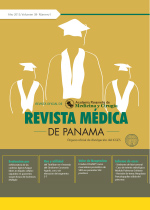Estenosis pulmonar con válvula Unicúspide. Diagnóstico por Resonancia Magnética Cardiaca. Informe de caso.
Autores/as
DOI:
https://doi.org/10.37980/im.journal.rmdp.2018495Resumen
[Pulmonary stenosis with Unicuspid valve. Diagnosis by Cardiac Magnetic Resonance. Case report.]
Resumen
La etiología más común de estenosis de la válvula pulmonar es congénita. La evaluación de la morfología de la válvula y de las estructuras adyacentes son importantes para correlacionar los síntomas del paciente y determinar el tratamiento. La estenosis pulmonar suele estar asociada con algún grado de obstrucción muscular subvalvular debido a la hipertrofia del miocardio del ventrículo derecho.
La morfología unicúspide de la válvula pulmonar es rara y su identificación es muy difícil en la ecocardiografía especialmente en los ancianos que tienen calcificación valvular. Presentamos el caso de una paciente femenina de 56 años de edad con estenosis pulmonar sintomática de etiología confusa en la que la evaluación por resonancia magnética cardiovascular (RMC) define la morfología de la válvula, severidad de la estenosis pulmonar y del tracto de salida del ventrículo derecho, tamaño y función ventricular derecha y dilatación postestenótica de arteria pulmonar.
Abstract
The most common etiology of pulmonary valve stenosis is congenital. The evaluation of the morphology of the valve and of the adjacent structures is important to correlate the patient's symptoms and determine the treatment. Pulmonary stenosis is usually associated with some degree of subvalvular muscle obstruction due to hypertrophy of the myocardium of the right ventricle.
The unicuspid morphology of the pulmonary valve is rare and its identification is very difficult in echocardiography, especially in the elderly who have valvular calcification. We present the case of a 56-year-old female patient with symptomatic pulmonary stenosis of confused etiology in which the evaluation of cardiovascular magnetic resonance (CMR) defines the morphology of the valve, severity of the pulmonary stenosis and the outflow tract of the ventricle, right, size and right ventricular function and poststenotic dilatation of the pulmonary artery.
Publicado
Número
Sección
Licencia
Derechos autoriales y de reproducibilidad. La Revista Médica de Panama es un ente académico, sin fines de lucro, que forma parte de la Academia Panameña de Medicina y Cirugía. Sus publicaciones son de tipo acceso gratuito de su contenido para uso individual y académico, sin restricción. Los derechos autoriales de cada artículo son retenidos por sus autores. Al Publicar en la Revista, el autor otorga Licencia permanente, exclusiva, e irrevocable a la Sociedad para la edición del manuscrito, y otorga a la empresa editorial, Infomedic International Licencia de uso de distribución, indexación y comercial exclusiva, permanente e irrevocable de su contenido y para la generación de productos y servicios derivados del mismo. En caso que el autor obtenga la licencia CC BY, el artículo y sus derivados son de libre acceso y distribución.






